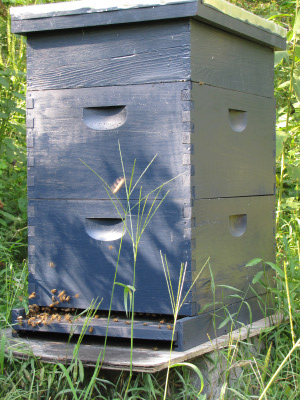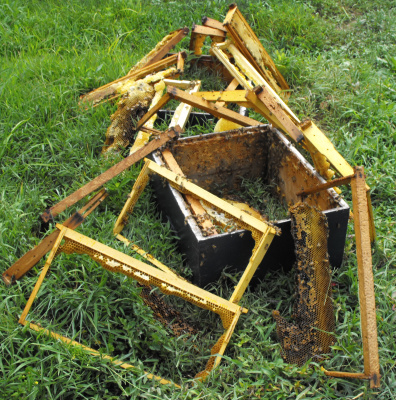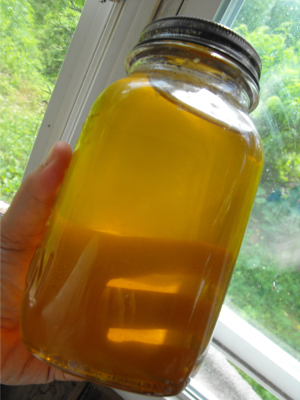
Experiments in natural beekeeping
 Our
honeybee experiments aren't really unique to our farm, but they are
outside the mainstream. They all began nearly two years ago when
we got our bees and chose to use foundationless frames
to decrease varroa mite
potential without chemicals (and to cut costs.) This year, we
added to the experiment by changing over to double deep brood
boxes to help the
colonies bulk up quicker in the spring and to prevent
swarming. We
also used a non-mainstream honey harvest technique of robbing
the bees in the late spring rather than in the fall to make sure the hive would
have enough food over the winter without feeding
sugar water.
Our
honeybee experiments aren't really unique to our farm, but they are
outside the mainstream. They all began nearly two years ago when
we got our bees and chose to use foundationless frames
to decrease varroa mite
potential without chemicals (and to cut costs.) This year, we
added to the experiment by changing over to double deep brood
boxes to help the
colonies bulk up quicker in the spring and to prevent
swarming. We
also used a non-mainstream honey harvest technique of robbing
the bees in the late spring rather than in the fall to make sure the hive would
have enough food over the winter without feeding
sugar water.
The results are a mixed
bag, but are primarily positive. So far, hive checks suggest that
our varroa
mite levels are
under control without resorting to pesticides, although one hive had
higher levels than I hoped when
I sampled in November.
We didn't see any swarming activity in the spring, so the double deep
with checkerboarding definitely worked as swarm prevention. And
the hive that we changed to double deep earliest in the spring stocked
up the majority of our year's honey, so double deeps are also
quite effective for getting more honey. Finally, we made it
through the first winter with no mortality, so harvesting in the spring
was a good choice.
 The primary problem we had
was a comb collapse
during hot weather soon after our honey harvest. I think that the
comb collapse was the result of all of my alternative methods merging
together in just the wrong way, and could easily be prevented in the
future by keeping all of the boxes at 10 frames rather than getting greedy
and downgrading to 9.
The primary problem we had
was a comb collapse
during hot weather soon after our honey harvest. I think that the
comb collapse was the result of all of my alternative methods merging
together in just the wrong way, and could easily be prevented in the
future by keeping all of the boxes at 10 frames rather than getting greedy
and downgrading to 9.
How do our results stack
up compared to those using traditional management (frames with
foundation, early fall harvests, chemicals in the hive to kill varroa
mites, and then feeding copious sugar water and/or corn syrup to get
the bees through the winter?) In terms of honey harvested, our
numbers were low --- the Kentucky extension service  suggests that the average
yield per hive should be 50 pounds (about 4 gallons), and we only got
4.5 gallons from all three hives combined. On the other hand, our
costs were also low --- we could have spent about $60 on foundation,
$25 on varroa mite medication, and maybe another $75 on feed for the
hives. In addition, we didn't have a single swarm and didn't lose
any hives. Clearly, our method fits the homesteading model of a
sustainable harvest even if it doesn't maximize yields.
suggests that the average
yield per hive should be 50 pounds (about 4 gallons), and we only got
4.5 gallons from all three hives combined. On the other hand, our
costs were also low --- we could have spent about $60 on foundation,
$25 on varroa mite medication, and maybe another $75 on feed for the
hives. In addition, we didn't have a single swarm and didn't lose
any hives. Clearly, our method fits the homesteading model of a
sustainable harvest even if it doesn't maximize yields.
In year three, we'll be
faced with yet more decisions in our natural honeybee setup. Do
we requeen or let the hives replace the queen when they see fit?
Should we try to split a hive to increase our numbers so we'll have
more honey for gifts? Should we cut out any of the old wax and
make them rebuild? If we do decide to split, should we try out
top bar hives for the sake of comparison? We're looking forward
to researching these and other questions in the year ahead.
This post is part of our 2010 experiments lunchtime series.
Read all of the entries:
|
Want more in-depth information? Browse through our books.
Or explore more posts by date or by subject.
About us: Anna Hess and Mark Hamilton spent over a decade living self-sufficiently in the mountains of Virginia before moving north to start over from scratch in the foothills of Ohio. They've experimented with permaculture, no-till gardening, trailersteading, home-based microbusinesses and much more, writing about their adventures in both blogs and books.
Want to be notified when new comments are posted on this page? Click on the RSS button after you add a comment to subscribe to the comment feed, or simply check the box beside "email replies to me" while writing your comment.
- Remove comment
- Remove comment
